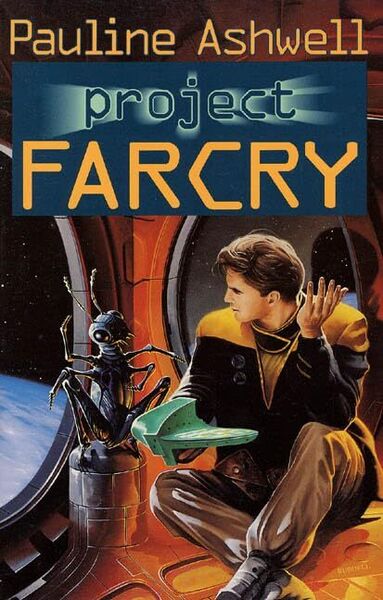Reach Out
Project Farcry
By Pauline Ashwell

21 Aug, 2025
0 comments
Pauline Ashwell’s 1995 Project Farcry is a stand-alone science fiction fix-up.
Dr. Jordan is not the first human to visit Lambda, a planet thirty light years from Earth. The expedition of which he is a part is the second expedition to Lambda. Dr. Jordan is the first human to bring his son to Lambda.
This is not because Dr. Jordan is a doting father. It is because his ex-wife Cora is a terrible mother.
Cora, the former Mrs. Jordan, has a keen eye for husbands who can offer her an improved social standing. Once their role has been fulfilled, she divorces her current husband and moves on to the next. Cora and Dr. Jordan were not married long. They were, however, married long enough to produce a son, Richard, a son whom Cora suddenly wants to send to a school for maladjusted children.
Despite having taken little interest in Richard until now, Dr. Jordan does not care to see Richard consigned to an institution on what seem to Dr. Jordan to be specious grounds. Thus, young Richard’s presence on Lambda.
Cora’s issue with Richard is that the boy is an inveterate snoop. This isn’t entirely false, but it’s also not voluntary. Richard is a telepath. Telepaths being quite rare, Richard has never been trained how to use his gift. Or as Richard is inclined to think of it, his disability.
News from the Lambda side: Big Sword, a Lambda sentient lifeform, is trying to assess and communicate with the Huge Ones (the visiting humans). The titanic newcomers appeared two generations earlier. This was only nine hundred 25.3‑hour Lambda days ago — but Big Sword’s people breed and live quickly.
The Huge Ones are no respecters of trees such as the one that gave birth to Big Sword. Thus far, Big Sword has not been able to bridge the communications gap. Not until the tiny alien encounters Richard.
Contact brings immediate benefits to the Lambdans. The humans and Lambdans come up with a scheme that allows Big Sword’s community to survive the new ecological challenges. One day the Lambdans will return the favor (alas, the short-lived alien will not live to see it).The Lambdans will be the key to an effort to recover an entire world from extra-dimensional exile.
~oOo~
Although (probably) set in a different continuity, Project Farcry reminded me of another Ashwell novel, Unwillingly to Earth. Both books are science fiction, both are about problem-solving IN SPACE, both are fix-ups, and both incorporate sections written in the 1950s and sections written decades later. Both novels involve young people isolated from conventional society by disabilities: Lizzie Lee, in Unwillingly, can’t use the standard reading machines; Richard, in Project Farcry, is an untrained telepath who cannot help overhearing other people’s secrets.
Project Farcry suffers from its stitched-together nature. The chunks in the fix-up are not well integrated, which made reading a bit of a chore. Pity, because there are a lot of interesting bits in the book.
One that I liked: the author points out that whether or not something is a disability really depends on context.
Another: like so many 20th SF works, the author expected a Dark Age after which humanity would rebound. However, her version of the Dark Age isn’t one huge catastrophe; the Disruption1 was just a pile-up of small disruptions.
Some of these were political in origin, some racist; a few were believed to have been backed by organized crime; but the majority — and all but one of the original six — began with the idea that Heaven was imminent and to be achieved by destroying unbelievers.
Standard enough. However, the way in which the Disruption played out is an example of Gibson’s adage that the future is unevenly distributed. The various disruptions, American and elsewhere, were regional enough in extent that civilization always survived somewhere, long enough for the World Federation to arise2.
A last big plus: Ashwell delivered alien aliens. Bug Sword is the size of a human hand, and although the alien appears to be an insect, Big Sword isn’t even an animal. The trees have two life stages, sessile and motile. Big Sword would be the latter, a life stage produced whenever the environment turns bad.
I wish the resulting fix-up hung together better, but it does have its good points. I would advise people to check the novel for themselves but it is long out of print.
Ah, well. Just one more Ashwell novel (she wrote three) to go. Whoops. It turns out The Man Who Stayed Behind is not a stand-alone novel, as I assumed, but part of this very fix-up. Oh, well. I suppose I could track down all the stories in Ashwell’s Common Universe setting.
1: USA delenda! But only for a while.
2: Which, alas, is not any sort of utopia. It doesn’t take the Federation long to evolve from “treat other ecosystems with respect” to “fuck it, bulldoze it all and replace the local lifeforms with Terran.”
The fifty-year old Federation is also prone to bureaucratic infighting, as its institutions are still evolving and each functionary wants as big a piece of the pie for themselves. As a result, Richard spends his career trying to harness telepathy for interstellar communication to help solve a specific pressing research issue… but bureaucratic territoriality means that the one group that refuses to take advantage of his work is the specific group he set out to help.
